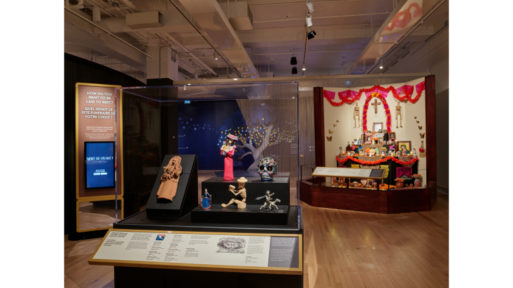
A view into the Death: Life’s Greatest Mystery exhibit
Credit: Royal Ontario Museum
The exhibit “Death: Life’s Greatest Mystery” is on display now at the Royal Ontario Museum in Toronto, Canada, through April 7, 2024. Originating at the Field Museum in Chicago in 2022, the exhibit traveled northward to open at ROM this fall. Its transdisciplinary approach involves cultural, scientific, and artistic perspectives to help viewers ponder the meaning of life and death.
The exhibit focuses on asking five big questions: What is death? What happens to my body? What happens to my spirit? Do I have to die? How will my death affect others? Co-chief curator at ROM, Chen Shen, explains that the beauty of this exhibit is that there is no one right answer to these questions, but instead she hopes that each viewer will come up with unique responses that matter to them.
The exhibit incorporates over 100 objects from the natural world, archeological discoveries, and contemporary art to present global perspectives on death and bereavement. Shen hopes that viewers will also make connections across cultures and recognize some similarities, such as the ways that ofrendas from Mexico and familial shrines in China both offer reverence to deceased ancestors.

A portion of the interactive art within the exhibit
Credit: Royal Ontario Museum
The exhibit is also designed to be interactive, offering multiple opportunities for viewer participation. One part of the exhibit has a touchscreen display asking viewers to answer questions such as whether they would like a doctor to attempt to revive their heart if it stops beating, and then displays audience responses. Another part of the exhibit is titled, “Before You Die,” and asks the viewer to write out what they want to do in this life before they die.
The exhibit is filled with gentle explorations. Some inspect ways that people have sought out immortality, while others contain placards labeled, “How to Prepare for Your Death,” discussing advance directives. Together, they aim to present both the cultural diversity of responses to questions of death, and also prompt personal reflection in the viewer about their own mortality.
As ROM sought to include a wide range of cultural perspectives, it did encounter some controversy. In the wake of the Oct. 7, 2023, Hamas attacks against Israel, ROM attempted to modify some of the art presented in the exhibit by Palestinian-American artist Jenin Yaseen. Her work had been commissioned for the exhibit to explore ideas of green burials in the Islamic tradition, and Yaseen wanted to depict how practicing traditional Islamic burial customs is a privilege that many Palestinians are not granted when the bodies of their deceased loved ones are held hostage by the Israel Defense Forces.
ROM expressed that Yaseen’s painting and words she had incorporated — such as “Palestine,” “exile,” and the name of a Palestinian village — could cause tension, and requested modifications. When Yaseen arrived at the exhibit to find that controversial parts of her painting had been cut off from view, she staged an 18 hour sit-in that garnered about 50 protestors outside the museum building. ROM staff relented the next day and displayed her art as originally intended.
Thus, as much as the exhibit tries to offer an unbiased view into death traditions throughout the world, it also highlights the political implications of death and grief.

 Death: Life’s Greatest Mystery
Death: Life’s Greatest Mystery


 How Dare You Die Now!
How Dare You Die Now!
 Debating Medical Aid in Dying
Debating Medical Aid in Dying
 “Help Me, Helen”
“Help Me, Helen”














